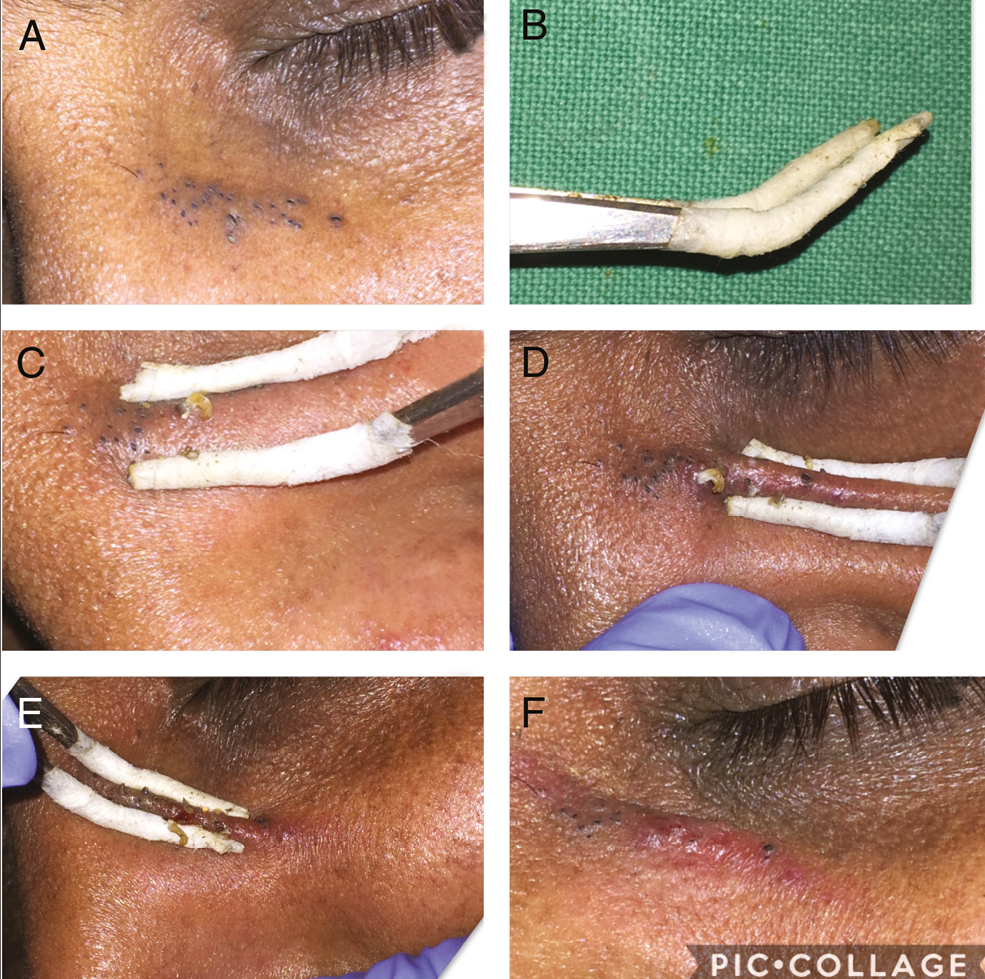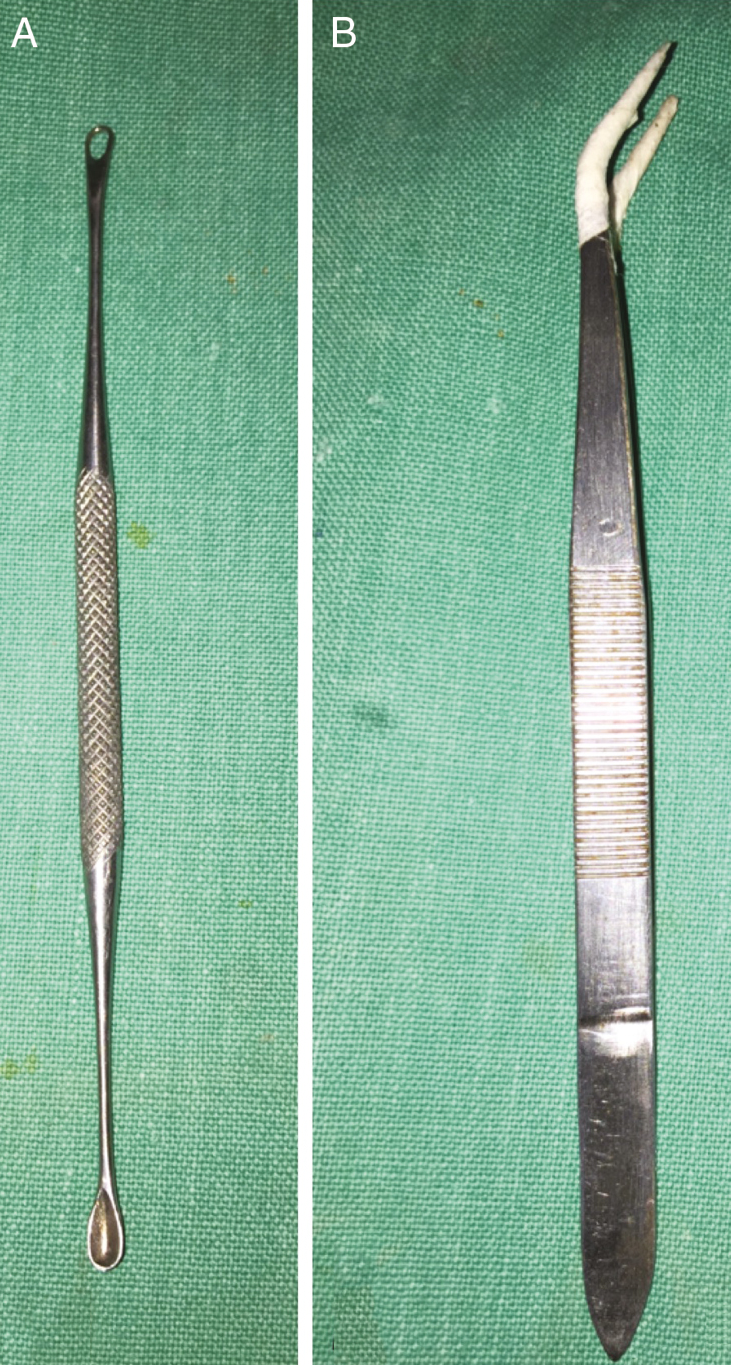Translate this page into:
Surgical Pearl: Dissecting Forceps Wrapped with Adhesive Tape for Atraumatic Periorbital Senile Comedone Extraction
Address for correspondence: Dr. Muhammed Mukhtar, Consultant Dermatologist, Mukhtar Skin Centre, Katihar Medical College Road, Katihar 854105, India. E-mail: drmmukhtar20@gmail.com
This is an open access journal, and articles are distributed under the terms of the Creative Commons Attribution-NonCommercial-ShareAlike 4.0 License, which allows others to remix, tweak, and build upon the work non-commercially, as long as appropriate credit is given and the new creations are licensed under the identical terms.
This article was originally published by Wolters Kluwer - Medknow and was migrated to Scientific Scholar after the change of Publisher.
Keywords
Micropore
old age
prick incision
subcutaneous bleeding
tissue injury
CHALLENGE
Senile comedone of variable size is common in the periorbital region and on the eyelids of old people. There are various instruments used to extract out its content.[12] However, these metallic and nonmetallic punching comedone extractors (conventional and non-conventional) could not be applied effectively and safely in the loose periorbital region and particularly over the eyelids[Figure 1A]. Moreover, a set of punching comedone extractors is required during the procedure due to the variability of micro-comedone size (1 mm to 5 mm). Over this area, squeezing of the lesions is a better option. In addition to this, direct squeezing out of the comedone with nails and naked dissecting forceps can cause more tissue injury and subcutaneous bleeding in old people. Here, micropore (which is readily available) wrapped tips of a dissecting forceps is used as an alternative to refill polytube insulated tips.[3]

- Conventional comedone extractor (A), angular dissecting forceps and micropore adhesive tape (B), and wrapped tips of forceps with tape (C)
SOLUTION
To alleviate the tissue injury at the site, I used readily available angular metallic dissecting (of 5 inch) and micropore tape in the clinic [Figure 1B]. For making the procedure atraumatic, the tips of the metallic forceps are wrapped with a small piece of micropore adhesive tape [Figure 1C]. After this, asepsis is done over the site with lotion povidone iodine and medicated alcohol [Figure 2A]. Opened senile comedone is gently directly compressed with the forceps to extract out the keratinous contents [Figure 2B-E]. In case of closed comedone; a tiny intrafollicular prick incision is given with a hypodermic needle before the extraction. Tissue injury and subcutaneous bleeding are not obviously observed at the site [Figure 1F]. Thus, dissecting forceps wrapped with adhesive tape could be a good and safe option as compared with a conventional punching comedone extractor for extracting out senile comedone of the periorbital region and eyelids [Figure 3A, B]. As an alternative to this wrapped dissecting forceps, disposable plastic forceps can be used.

- (A) The senile comedone over loose, thin infra-orbital region. (B–E) The senile comedone is extracted out with a tissue forceps wrapped with micropore adhesive tape. (F) The extracted senile comedone lesions

- Conventional comedone extractor (A) and micropore wrapped forceps (B) for periorbital region and eyelid for comedone extraction
Declaration of patient consent
The authors certify that they have obtained all appropriate patient consent forms. In the form, the patient(s) has/ have given his/ her/ their consent for his/ her/ their images and other clinical information to be reported in the journal. The patients understand that their names and initials will not be published and due efforts will be made to conceal their identity, but anonymity cannot be guaranteed.
Financial support and sponsorship
Nil.
Conflicts of interest
There are no conflicts of interest.
Acknowledgments
None
REFERENCES
- Surgical pearl: The safety pin as a better alternative to the versatile paper clip comedo extractor. Int J Dermatol. 2004;43:967-8.
- [Google Scholar]
- An effective extraction technique for the treatment of closed macrocomedones. Dermatol Surg. 2003;29:741-4.
- [Google Scholar]
- Surgical pearl: Dissecting forceps with polytube for periorbital senile comedone extraction. J Skin Stem Cell. 2020;7:e104632.
- [Google Scholar]






